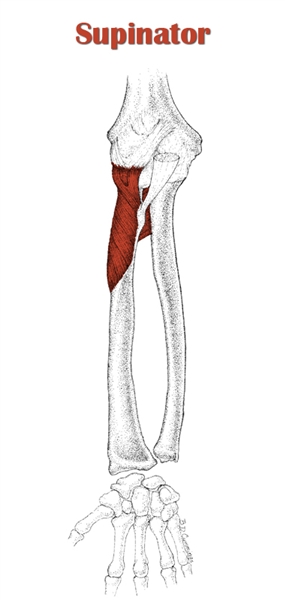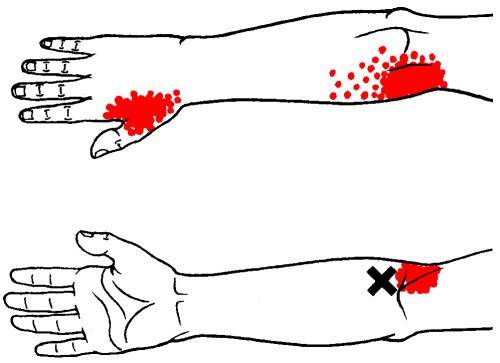The supinator (L. supinare, to lay on back or turn up) is a relatively wide muscle on the upper forearm.

It spirals from the back and outside of the forearm to the front, crossing over the space between the radius and ulna…
…This unique location allows it to carry out its primary function of forearm supination.
Note: It is only a prime mover during slow and unresisted supination when the elbow is straight (or when the elbow is bent, but the forearm is supported). The biceps brachii is the prime mover during fast or resisted supination with the elbow bent (the biceps is also active during resisted supination when the elbow is straight).
The supinator is part of the deep posterior compartment of the forearm.
It is found deep to the brachioradialis, extensor carpi radialis longus and brevis, and extensor digitorum.
From a posterior view of the forearm, the supinator is lateral to the anconeus. From an anterior view, it is lateral to the distal biceps tendon.
The supinator consists of a deep head and a superficial head, though they are not always clearly distinguishable.
Both the deep and the superficial fibers run inferolaterally from origin to insertion, curving around the outside of the forearm.
Also Called
- Supinator brevis
- Back of the forearm
Origin, Insertion, Action & Nerve Supply
| Muscle | Origin | Insertion | Action | Nerve Supply |
|---|---|---|---|---|
| Deep Head | Supinator fossa and supinator crest of the ulna | Posterior, lateral and anterior surfaces of the proximal third of radius, between the anterior and posterior oblique lines of the radius | Forearm supination | Posterior interosseous nerve (C7-C8) |
| Superficial Head |
|
Exercises:
Note: The table below only includes direct supinator exercises. However, the supinator is also trained indirectly during supinated dumbbell curls. It also gets worked indirectly via isometric contraction in exercises involving a supinated grip (e.g. barbell curls, underhand rows, chin ups).
| Type | Name | Picture |
|---|---|---|
| Dumbbell: |
 Tutorial: N/A
 Tutorial: N/A
|
|
| Cable: |
 Tutorial: N/A
|
|
| Machine: |
 Tutorial: N/A
 Tutorial: N/A
|
|
| Other: |
 Tutorial: N/A
 Tutorial: N/A
 Tutorial: N/A
|
Stretches & Myofascial Release Techniques:
Stretches
| Name | Picture |
|---|---|
 Tutorial: N/A
 Tutorial: N/A
|
Self Myofascial Release Techniques
When using these techniques, give special attention to the trigger point shown in the image below.
| Tool | Picture |
|---|---|
 Tutorial: N/A
 Tutorial: N/A
 Tutorial: N/A
 Tutorial: N/A
|
Common Issues:
- Overactive/Short Supinator: Overuse of the supinator, from repetitive activities involving forearm supination/pronation or isometric contraction of the supinator, can cause it to become overactive and short. Examples of such activities include swinging a bat or club, performing certain tennis strokes, turning a screwdriver or wrench, and shoveling. Exercises featuring the movement of supination (e.g. dumbbell supination, dumbbell curls with supination) or the use of a supinated grip (e.g. barbell curls, chin ups) can also contribute to overuse. If the supinator becomes excessively overactive/short, it can limit forearm pronation range of motion. The shoulder may compensate by going into humeral internal rotation to make up for the limited pronation. This increases the likelihood of shoulder injury. As the supinator becomes more overactive, its soft tissue quality declines, which may lead to either of the following painful conditions:
- Supinator Syndrome: Supinator syndrome is characterized by the compression of the posterior interosseous nerve as it enters the supinator via the arcade of Frohse or as it exits its distal end. There are a number of reasons why the arcade of Frohse, or the supinator itself, can become constricted and compress the nerve: Common causes include an muscle overactivity/shortness, excessive hypertrophy and scar tissue/adhesion build up, all of which stem from overuse. The symptoms include pain in the upper forearm, sometimes radiating down to the wrist, and weakness in the finger extensors. Weakness in supinator, itself, is not always seen because it is typically innervated before the point of nerve compression.
- Lateral epicondylitis: Lateral epicondylitis, better known as tennis elbow, is characterized by pain in the outer elbow resulting from degeneration of the common extensor tendon. The damage to the tendon is caused by overuse and tightness of the wrist extensors and supinator.
Training Notes:
- If you have an overactive/short supinator, do the following:
- Cut down on any repetitive activities that involve a statically holding your forearm in a supinated position, or moving your forearm through supination or pronation. As previously mentioned, such activities include swinging a bat or club, tennis, or using tools like a screwdriver, wrench and shovel.
- Avoid any direct supinator exercises.
- Substitute a pronated grip or neutral grip in place of a supinated grip on exercises where it’s practical. For example: neutral grip or overhand rows instead of underhand rows; pull ups or neutral grip pull ups instead of chin ups.
- Perform supinator stretches and release techniques. Do them every day as part of a comprehensive mobility routine, and before workouts involving underhand grip exercises (e.g. curls, chin ups) or forearm exercises.
- An overactive/short supinator is often indicative of tight wrist extensors. See how to treat overactive/short wrist extensors.
- If you think you have supinator syndrome, see how to treat supinator syndrome (article coming soon).
- If you have lateral epicondylitis, read how to treat tennis elbow (article coming soon).
- If you don’t have any issues with your supinator, then it’s not necessary to train it directly. That said, it’s okay to do some direct work just to keep the muscle strong. For this purpose, do 2-3 sets of 8-15 reps of any isolation supinator exercise 1-2 times per week when you do grip training or forearm work. Use the same parameters for pronator teres training to keep your muscles balanced.


